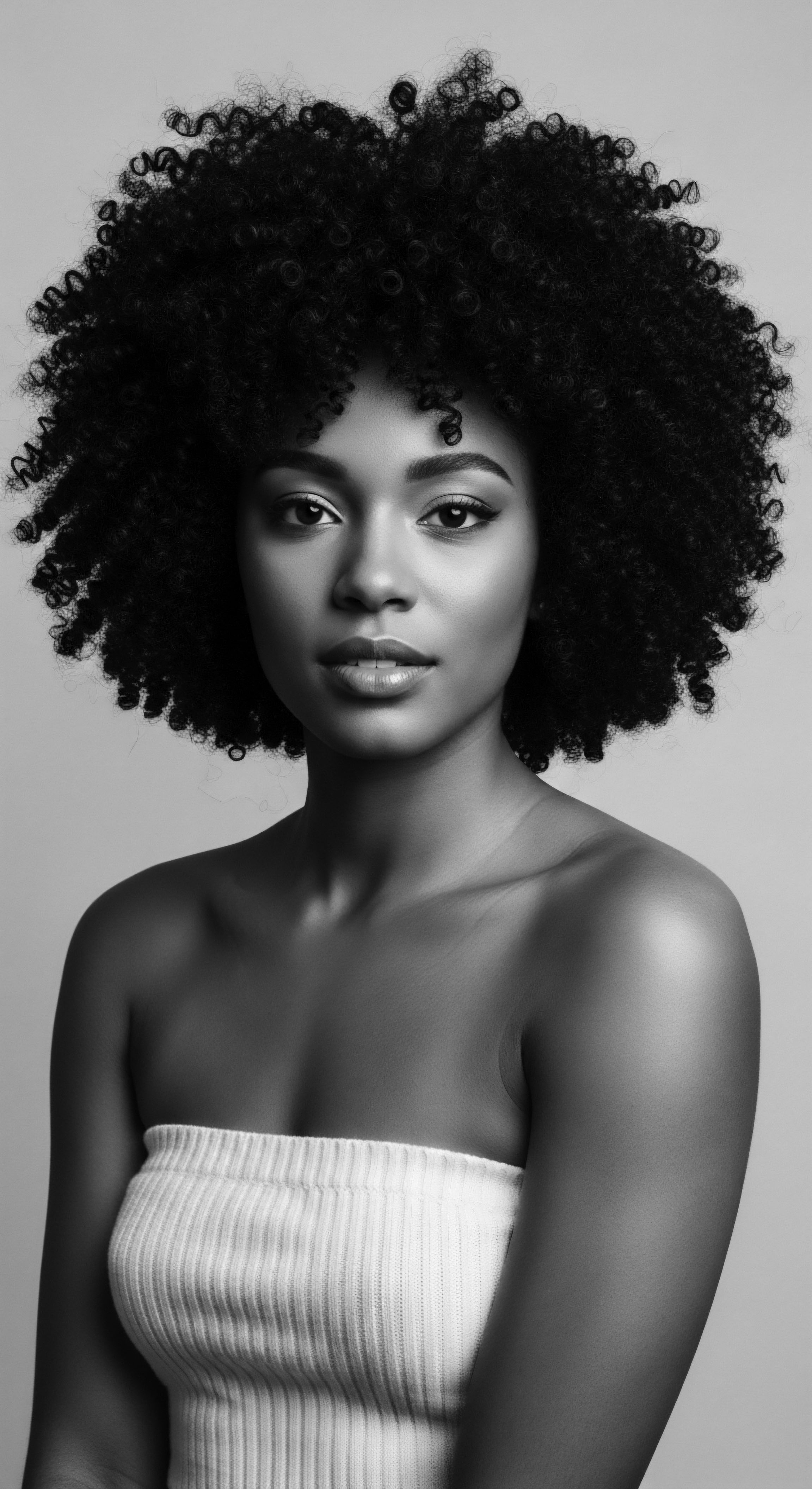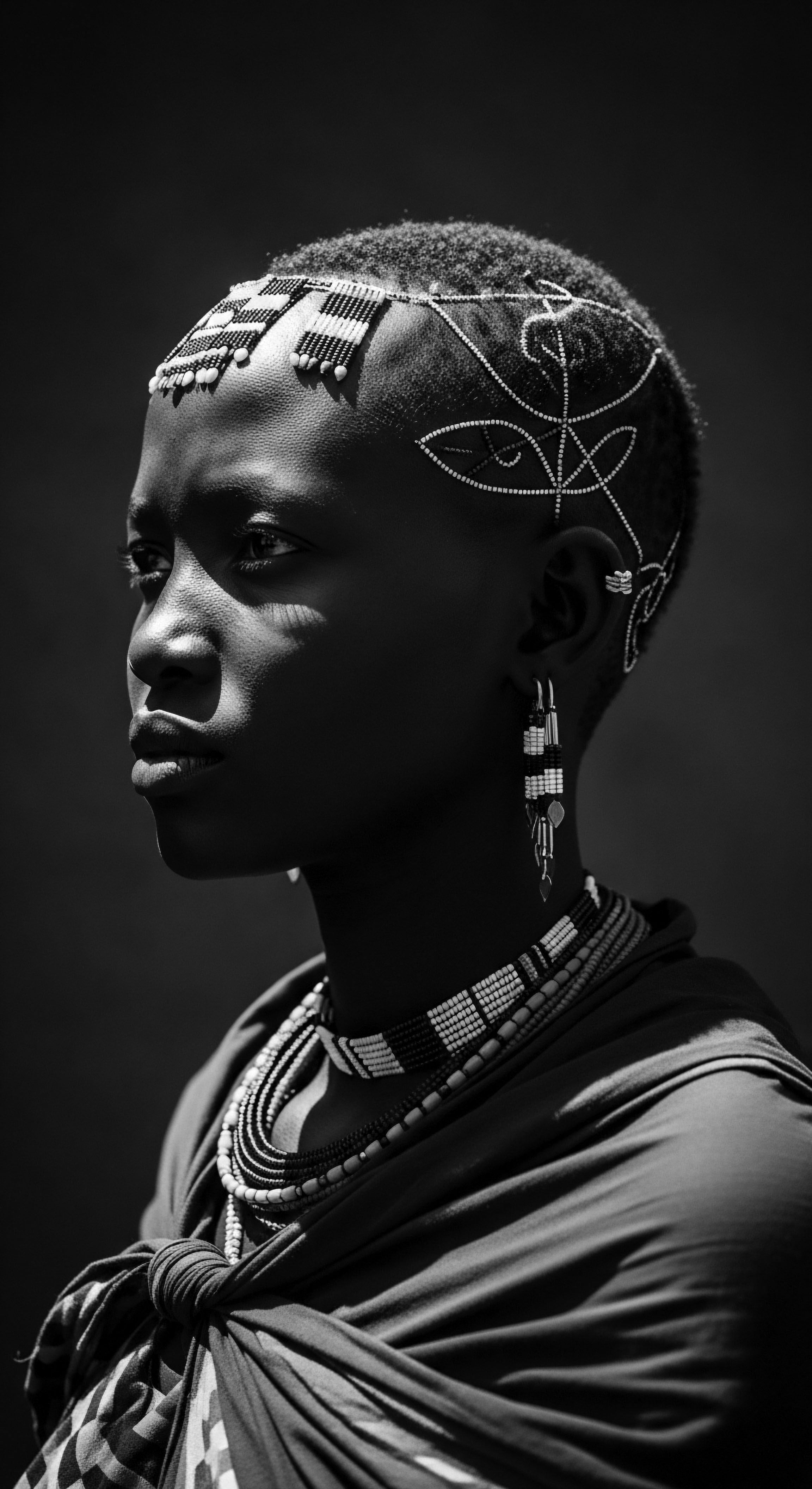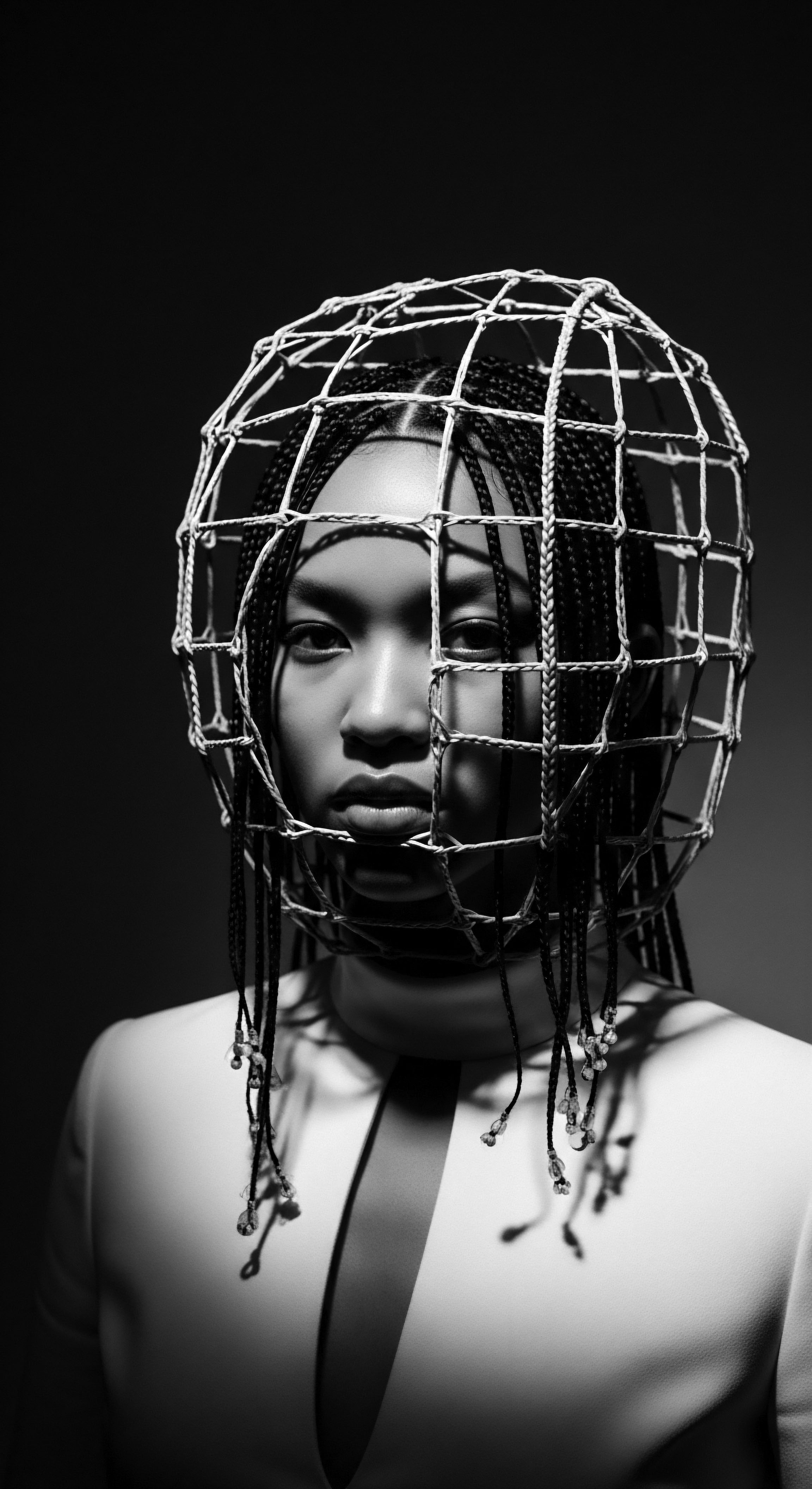
Roots
The stories held within each strand of textured hair are whispered across generations, a silent language of resilience. For those of us connected to the vast and varied tapestry of the African diaspora, our hair is more than simply protein and pigment; it is a living archive, a repository of ancestral wisdom, and a testament to enduring spirit. From the earliest days on the African continent, care for hair was not an idle vanity, but a profound ritual, an act of intentional preservation, and a cultural statement. The practice of oiling, in particular, was deeply woven into these ancient traditions, reflecting a knowing intimacy with the earth’s bounty and the inherent needs of coily, kinky, and wavy textures.
Before the forced transatlantic migration, countless communities across Africa held indigenous knowledge of plants and their potent properties. Oils, often pressed from seeds, nuts, or fruits, served as more than just conditioners. They were protective balms against harsh sun and arid winds, agents of spiritual anointing, and vital components in intricate styling that conveyed status, age, and identity.
Think of the rich, earthy scent of Shea Butter from West Africa, or the golden pour of Argan Oil from North Africa. These were not random choices; they were selections born of centuries of observation and deep understanding of what nourished the scalp and preserved the hair fiber.
The very anatomy of textured hair, with its unique helical structure and frequent turns, often presents a challenge for natural sebum to travel down the hair shaft, leaving strands prone to dryness and breakage. This inherent characteristic, combined with the often-harsh environmental conditions of many African regions, meant that external lubrication and sealing were not merely beneficial; they were absolutely necessary for maintaining hair health and longevity. Oils provided that essential external layer, acting as a barrier, trapping moisture within the hair cortex, and smoothing the cuticle.
The ancestral practice of hair oiling in Africa was a sophisticated interplay of environmental adaptation, deep botanical knowledge, and profound cultural expression.
When the currents of history violently pulled African peoples from their homelands, these cherished traditions, though disrupted, did not vanish. They traveled, carried in memory, in spirit, and sometimes, in the very seeds and plants resilient enough to make the horrific journey. The fundamental understanding of oils as agents of resilience became even more critical in new, often hostile, environments where different climates and brutal conditions threatened both body and spirit. The adaptation of traditional oil use in the diaspora began not as a choice, but as a continuation of a practice deeply intertwined with survival and the quiet assertion of self.

What Did Traditional African Oil Use Prioritize For Hair?
Ancient African communities valued oils for specific properties that directly addressed the needs of textured hair long before modern chemistry could quantify them. They instinctively understood the power of fatty acids, vitamins, and emollients.
- Protection from Elements ❉ Oils acted as a shield against sun, dust, and wind, crucial for outdoor lifestyles.
- Scalp Health ❉ Massaging oils into the scalp promoted circulation and addressed dryness or irritation.
- Moisture Retention ❉ By sealing the hair cuticle, oils helped textured strands hold onto the water they absorbed.
- Lubrication for Styling ❉ Oils facilitated easier manipulation of hair for braids, twists, and elaborate coiffures, reducing friction and breakage.
This traditional knowledge, passed down through oral histories and lived practices, formed the foundational codex of textured hair care, a codex that would undergo transformation yet persist through the crucible of the diaspora.

Ritual
The journey from ancestral lands across vast waters meant that traditional hair oiling practices, while retaining their spiritual and practical core, had to adapt. The familiar botanicals of home were often inaccessible, forcing diaspora communities to seek out new, locally available resources that offered similar benefits. This creative adaptation, a testament to enduring ingenuity, saw communities making do, innovating, and sometimes, creating entirely new traditions from the fragments of the old and the discoveries of the new world. The daily rhythm of oiling, once a part of life on the continent, transformed into a quiet act of defiance and self-preservation in the face of brutal enslavement and systemic oppression.
In the Caribbean, for instance, the scarcity of traditional African nuts and seeds led to the increased reliance on plants readily available in tropical climates. The unassuming Castor Bean, already known for its medicinal properties, became a cornerstone. Its thick, viscous oil, often processed through roasting the beans before pressing (a technique that gives Jamaican Black Castor Oil its distinctive color and higher alkalinity), offered unparalleled sealing and strengthening attributes for hair.
This adaptation was not just practical; it was a deeply symbolic act. In a world bent on stripping identity, maintaining hair, oiling it, and styling it became a powerful, albeit subtle, declaration of selfhood and cultural continuity.
Communities would gather, often in the quiet hours after a grueling day, to tend to one another’s hair. These were not just hair care sessions; they were communal gatherings, spaces where stories were shared, wisdom imparted, and bonds reinforced. The hands that gently massaged oil into scalps were hands that offered comfort, solidarity, and a tangible connection to a shared heritage. The oil itself became a conduit for these shared experiences, absorbing the collective spirit and the whispered hopes for a future where hair, and by extension, identity, could truly thrive.
Oiling rituals in the diaspora became a vibrant testament to resilience, adapting ancient wisdom to new landscapes and forging new bonds of community through shared care.
Consider the evolving nomenclature. While direct African terms might have been lost or hybridized, the function of the oils remained paramount. Whether it was called a ‘grease’ in the American South, an ‘ointment’ in Haiti, or simply ‘the oil’ within a family, its purpose was clear ❉ to protect, to moisturize, and to keep the hair pliable, reducing breakage and encouraging length retention. This pragmatism was rooted in a deep understanding of textured hair’s specific needs.
Without adequate lubrication, textured strands are prone to mechanical stress from manipulation, leading to split ends and breakage. Oils provided that essential slip and protection.
The evolution of oil processing itself within the diaspora also speaks to this adaptive spirit. From rudimentary crushing and boiling to more refined pressing techniques developed over generations, these methods were designed to yield the most potent oil possible from available resources. This practical alchemy ensured that the benefits—the richness of fatty acids, the occlusive properties, the ability to calm an irritated scalp—were preserved and passed on.

How Did Necessity Shape Oil Adaptations?
The conditions of the diaspora necessitated innovation and resourcefulness in maintaining hair care practices. The focus shifted from abundant, specialized botanicals to whatever could be found, cultivated, or traded.
- Regional Availability ❉ New World plants like castor beans, coconut, and various nut oils replaced or supplemented traditional African oils.
- Oral Tradition Persistence ❉ Knowledge of oiling benefits and methods survived through oral transmission, ensuring the continuation of practice.
- Community Sharing ❉ Limited resources meant shared knowledge and shared application, solidifying the communal aspect of hair care.
- Spiritual and Medicinal Links ❉ Oils often retained their connections to healing and spiritual well-being, imbuing them with deeper significance beyond mere aesthetics.
This adaptive spirit highlights a powerful aspect of textured hair heritage ❉ its capacity for transformation without losing its foundational purpose. The oiling ritual, therefore, stands as a symbol of cultural tenacity, a quiet revolution played out in the daily tending of hair.
| Traditional African Oil/Source Shea Butter (Vitellaria paradoxa) |
| Original Use Skin and hair emollient, protection, spiritual rites |
| Diaspora Adaptation/Equivalent Continued widespread use where accessible; sometimes supplemented by cocoa butter |
| Adaptation's Primary Benefit Intense moisturization, emollient barrier |
| Traditional African Oil/Source Palm Oil (Elaeis guineensis) |
| Original Use Hair softening, scalp health, ceremonial use |
| Diaspora Adaptation/Equivalent Used in parts of the Caribbean and South America (e.g. Brazil) due to cultivation |
| Adaptation's Primary Benefit Deep conditioning, scalp nourishment |
| Traditional African Oil/Source Argan Oil (Argania spinosa) |
| Original Use Hair gloss, scalp treatment, anti-aging |
| Diaspora Adaptation/Equivalent Limited direct use; concept of 'light, nourishing oil' replaced by coconut or olive in some regions |
| Adaptation's Primary Benefit Hair elasticity, shine |
| Traditional African Oil/Source Baobab Oil (Adansonia digitata) |
| Original Use Hair strength, elasticity, scalp health |
| Diaspora Adaptation/Equivalent Concept of 'strengthening oil' often found in castor oil or coconut oil applications |
| Adaptation's Primary Benefit Hair strengthening, barrier protection |
| Traditional African Oil/Source Coconut Oil (Cocos nucifera) |
| Original Use N/A (originates elsewhere, widespread in African coastal trade) |
| Diaspora Adaptation/Equivalent Widespread adoption across the Caribbean and Americas, especially tropical regions |
| Adaptation's Primary Benefit Moisture retention, protein binding, scalp soothing |
| Traditional African Oil/Source Castor Oil (Ricinus communis) |
| Original Use Medicinal, lamp oil (Africa); Hair growth/strength (Diaspora) |
| Diaspora Adaptation/Equivalent Became a primary hair oil, particularly 'Jamaican Black Castor Oil' |
| Adaptation's Primary Benefit Hair growth stimulation, scalp health, sealing, strengthening |
| Traditional African Oil/Source This table illustrates the resourceful spirit of African diaspora communities, who found new ways to maintain ancestral hair care principles using locally available ingredients. |

Relay
The journey of oil use for hair resilience in the African diaspora is a compelling testament to the intergenerational transmission of knowledge, adapting elemental science with cultural necessity. It’s a sophisticated narrative, one where the wisdom of ancestors, often dismissed as folklore, finds profound resonance in contemporary scientific understanding. The deep, coily patterns of textured hair, for all their beauty, are anatomically more susceptible to moisture loss and structural fragility compared to straighter hair types. This is partly due to the elliptical shape of the hair shaft and the way its cuticles often stand slightly open at the curves, making it harder for the hair to retain water and easier for it to incur damage from friction.
Traditional oiling practices, therefore, were not simply about making hair look shiny. They were a strategic defense. Oils, being hydrophobic, create a barrier on the hair shaft, effectively sealing in moisture already present or applied (like water or a leave-in conditioner). This occlusive layer reduces the rate of water evaporation from the hair, a phenomenon crucial for maintaining hydration in dry environments or when hair is frequently manipulated.
Moreover, certain oils, particularly those rich in saturated and monounsaturated fatty acids with smaller molecular structures, like Coconut Oil, possess the ability to penetrate the hair shaft, not just sit on its surface. This internal penetration helps to strengthen the hair from within by reducing protein loss, especially during washing, as noted by studies on coconut oil’s impact on hair fiber . This scientific validation underscores the intuitive wisdom of centuries of diaspora practices.
The consistent application of oils also provided essential lubrication, minimizing the friction that inevitably occurs during styling, combing, or even sleeping. This mechanical protection directly translates to reduced breakage, allowing textured hair to achieve and maintain length, a challenge often faced by individuals with coily strands.
The persistent and adaptive use of oils within African diaspora communities highlights a deep, ancestral understanding of textured hair’s unique structural and moisture needs.
Beyond the physiological benefits, the role of oiling in cultural and identity preservation cannot be overstated. During periods of immense hardship and systemic dehumanization, particularly throughout slavery and its aftermath, the ability to care for one’s hair, however meager the resources, became an act of profound self-respect and cultural affirmation. Hair, in its natural, unadorned state, was often deemed ‘unruly’ or ‘unacceptable’ by dominant societal norms. The meticulous process of washing, oiling, and styling, often done in secret or within communal spaces, was a quiet rebellion.
It allowed individuals to connect with their ancestral lineage, affirm their inherent beauty, and resist the narrative that sought to diminish them. For instance, the clandestine nature of hair care during slavery underscores how these rituals, including oiling, were not just about aesthetics but about the preservation of dignity and connection to homeland practices (Byrd & Tharps, 2001).
The ingenuity of adaptation extended to creating compounded oil mixtures, often infused with herbs and plants for additional benefits. These concoctions, passed down through family lines, represent localized knowledge systems, each blend a unique response to specific hair concerns and regional botanical availability. A classic example is the evolution of Jamaican Black Castor Oil (JBCO). While castor oil itself has ancient roots, the unique processing method of roasting the beans before pressing and then boiling with the ash of certain plants (which increases the alkalinity and purported efficacy) was developed in Jamaica, born from the practical needs and botanical knowledge of enslaved Africans and their descendants on the island.
This specific diaspora innovation became a symbol of resilience and a staple for promoting hair growth and scalp health within global textured hair communities. Its widespread use, particularly in the 20th and 21st centuries, is a direct relay of ancestral adaptation, proving that traditional methods, when deeply understood and innovated upon, continue to offer profound solutions.

What Are The Scientific Underpinnings of Oil Benefits for Coily Hair?
The efficacy of traditional oiling practices for textured hair is increasingly supported by scientific research, aligning ancestral wisdom with modern understanding.
- Lipid Reinforcement ❉ Oils, rich in lipids, help to replenish the hair’s natural lipid layer, which is often depleted in highly porous, textured strands.
- Cuticle Smoothing ❉ The application of oils can help to flatten the hair’s cuticle, reducing tangles and increasing shine.
- Elasticity Enhancement ❉ Regular oil treatments can improve the elasticity of hair, making it less prone to snapping under tension.
- Antimicrobial Properties ❉ Many traditional oils possess natural antimicrobial or antifungal properties, contributing to a healthier scalp environment.
This blend of ancestral practice and modern science highlights how the methods developed in the diaspora were not accidental, but rather a form of deeply intuitive, effective bio-engineering for hair resilience.
| Oil (Common Diaspora Use) Coconut Oil (Cocos nucifera) |
| Primary Fatty Acid Composition Lauric Acid (saturated) |
| Molecular Attributes for Hair Small molecular weight, high affinity for hair proteins |
| Resilience Benefit Deep penetration to reduce protein loss, adds strength, moisture sealing |
| Oil (Common Diaspora Use) Castor Oil (Ricinus communis) |
| Primary Fatty Acid Composition Ricinoleic Acid (unsaturated) |
| Molecular Attributes for Hair High viscosity, acts as a humectant and occlusive |
| Resilience Benefit Thickens hair, scalp circulation, strong moisture barrier, promotes healthy growth environment |
| Oil (Common Diaspora Use) Olive Oil (Olea europaea) |
| Primary Fatty Acid Composition Oleic Acid (monounsaturated), Linoleic Acid (polyunsaturated) |
| Molecular Attributes for Hair Moderate molecular weight, good for sealing and conditioning |
| Resilience Benefit Softens, adds shine, provides external moisture barrier, some penetration |
| Oil (Common Diaspora Use) Jojoba Oil (Simmondsia chinensis) |
| Primary Fatty Acid Composition Wax esters (structurally similar to sebum) |
| Molecular Attributes for Hair Lightweight, non-greasy, mimic natural scalp oils |
| Resilience Benefit Balances scalp sebum, conditions hair without heaviness, scalp health |
| Oil (Common Diaspora Use) Avocado Oil (Persea americana) |
| Primary Fatty Acid Composition Oleic Acid (monounsaturated), Linoleic Acid (polyunsaturated) |
| Molecular Attributes for Hair Larger molecular weight, rich in vitamins (A, D, E) |
| Resilience Benefit Deep conditioning, nourishes scalp, excellent moisture sealant for thicker strands |
| Oil (Common Diaspora Use) The specific lipid profiles of these oils explain their efficacy in providing moisture, strength, and protection to textured hair, validating ancestral applications. |
The persistence of these practices, often against immense pressure to conform to Eurocentric beauty standards, speaks volumes. For generations, Black and mixed-race communities have used oiling not just as a beauty regimen but as a cultural anchor, a connection to the past, and a source of inherent power. This legacy, passed down through kitchens and salons, family gatherings and whispered instructions, is a living, breathing archive of hair wisdom.

Reflection
The enduring wisdom of African diaspora communities, manifest in their intricate relationship with hair and the purposeful use of oils, stands as a luminous beacon. It is a story told not just through historical texts, but in the very fiber of textured hair, in the way light catches its intricate patterns, and in the resilience it embodies. The journey of oil use, from the ancient forests of Africa to the new landscapes of the diaspora, is a testament to adaptive brilliance—a profound understanding of natural elements, reinterpreted and passed down through the generations.
Each drop of oil, carefully applied, carries the memory of hands that came before, hands that knew the subtle language of strands, hands that transformed humble botanicals into agents of strength and beauty. It is a legacy that transcends mere aesthetics, speaking to deeper truths about identity, self-preservation, and the unwavering spirit of a people. This unbroken chain of care, this ‘Soul of a Strand’ ethos, reminds us that our hair is not just a part of us; it is a profound connection to our past, a vibrant expression of our present, and a promising guide for our future. The continuous adaptation of traditional oil use for hair resilience is a living, breathing archive, where every textured curl and coil holds a piece of an extraordinary heritage.

References
- Byrd, A. D. & Tharps, L. D. (2001). Hair Story ❉ Untangling the Roots of Black Hair in America. St. Martin’s Griffin.
- Rele, V. G. & Mohile, R. B. (2003). Effect of mineral oil, sunflower oil, and coconut oil on prevention of hair damage. Journal of Cosmetic Science, 54(2), 175-192.
- Opoku-Agyemang, R. (2018). Black Hair Culture ❉ A Cultural History of Black Hair. University of California Press.
- Gordon, S. (1998). African American Women and the Politics of Hair. Rutgers University Press.
- Tharps, L. D. (2014). Hair Story, Second Edition ❉ Untangling the Roots of Black Hair in America. St. Martin’s Press.
- Akbari, R. & Mirzazadeh, A. (2018). The effect of different oils on hair shaft properties ❉ A systematic review. Journal of Cosmetic Dermatology, 17(5), 785-791.
- Parr, B. (2010). African Hair ❉ Its Cultural Significance. Africa World Press.
